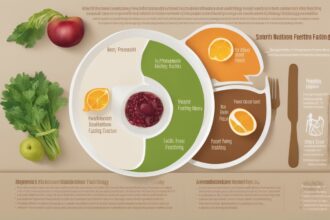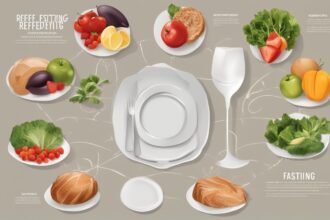Fasting, whether for health, spiritual, or weight loss reasons, has gained immense popularity in recent years. However, what happens after the fast is just as critical as the fast itself. Proper refeeding is essential to avoid digestive distress, nutrient imbalances, and other health issues. This post dives deep into optimal meal planning after fasting, offering actionable strategies to ensure a smooth transition back to regular eating while maximizing the benefits of your fast.
Why Optimal Meal Planning After Fasting Matters
Breaking a fast without a well-thought-out plan can lead to a phenomenon known as refeeding syndrome, a potentially dangerous condition caused by rapid shifts in electrolytes and fluids. Even without severe consequences, poor refeeding can cause bloating, nausea, and energy crashes. Optimal meal planning after fasting ensures that your body receives the right nutrients in the right amounts at the right time, helping to restore energy, support digestion, and maintain the benefits of fasting, such as improved insulin sensitivity and reduced inflammation.
Start Small: The Importance of Gradual Refeeding
After a prolonged fast, your digestive system is in a delicate state. Jumping straight into heavy meals can overwhelm your stomach and intestines. Instead, begin with small, easily digestible foods. For instance, start with clear broths, vegetable soups, or diluted fruit juices during the first 12–24 hours after a fast. These options provide hydration and gentle nourishment without taxing your system. As you progress, slowly introduce soft foods like mashed potatoes or steamed vegetables before moving to more complex meals. This gradual approach is a cornerstone of optimal meal planning after fasting.
For additional insights on starting small after a fast, check out our post on Post-Fasting Digestion Tips.
Focus on Nutrient-Dense Foods
Once your digestive system is ready for more substantial meals, prioritize nutrient-dense foods to replenish what your body may have depleted during the fast. Foods rich in vitamins, minerals, and electrolytes—such as bananas, avocados, and leafy greens—help restore potassium, magnesium, and other essential nutrients. Incorporate lean proteins like chicken or fish to rebuild muscle tissue, and include healthy fats from sources like olive oil or nuts to support energy levels. A balanced approach to nutrient intake is key to optimal meal planning after fasting and prevents deficiencies that could undermine your health goals.
Learn more about nutrient-dense foods in our guide to Building a Nutrient-Rich Diet.
Timing Your Meals for Maximum Benefit
The timing of your meals after fasting plays a significant role in how your body adjusts. Rather than returning to a standard three-meals-a-day schedule immediately, consider eating smaller, more frequent meals throughout the day. This strategy helps prevent blood sugar spikes and reduces strain on your digestive system. For example, after a 24-hour fast, you might eat five small meals spaced 2–3 hours apart on the first day of refeeding. Gradually increase portion sizes and reduce meal frequency over the next few days. Timing is a critical element of optimal meal planning after fasting and can make the difference between a smooth transition and digestive discomfort.
Hydration: A Non-Negotiable in Refeeding
Hydration is often overlooked but is absolutely vital during the refeeding phase. Fasting can deplete your body’s water and electrolyte stores, so replenishing fluids should be a priority. Start with plain water or herbal teas, and avoid sugary or caffeinated beverages that can dehydrate you further. As you progress, consider adding electrolyte solutions or coconut water to restore sodium and potassium levels. Proper hydration supports digestion, energy levels, and overall recovery, making it an essential component of optimal meal planning after fasting.
For more tips on staying hydrated, read our article on Hydration Strategies Post-Fasting.
Listen to Your Body and Avoid Common Pitfalls
Every individual’s response to fasting and refeeding is unique, so it’s crucial to pay attention to your body’s signals. If you experience bloating, fatigue, or nausea, scale back on portion sizes or stick to simpler foods for a little longer. Common pitfalls during refeeding include overeating, consuming processed foods, or rushing the process. Avoid these by sticking to whole, unprocessed foods and pacing yourself. Personalizing your approach based on how you feel is a fundamental principle of optimal meal planning after fasting.
Disclaimer: The information provided in this post is for educational purposes only and is not intended as medical advice. Fasting and refeeding can have significant effects on your health, and individual needs vary. Always consult with a healthcare professional or registered dietitian before starting any fasting regimen or refeeding plan, especially if you have underlying health conditions or are on medication.
References
- Mehanna, H. M., Moledina, J., & Travis, J. (2008). Refeeding syndrome: what it is, and how to prevent and treat it. BMJ.
- Harvard Health Publishing. (2018). Intermittent fasting: Surprising update.
- Mayo Clinic. (n.d.). Fasting: What you need to know.
- WebMD. (n.d.). Diet Myth or Truth: Fasting Is Effective for Weight Loss.
- British Nutrition Foundation. (n.d.). Fasting: What does the science say?
This content is for informational purposes only and not a substitute for professional advice.






